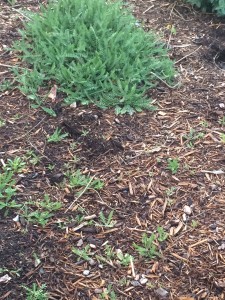Hello fellow readers,
I love when folks send pictures of their gardens especially when their plants make new babies. Kathy of Andover sent a picture of her baby yarrows. The dilemma though, is she has more babies than she can handle.
Yarrow are indeed ambitious plants native to most of the northern hemisphere. The native or common yarrow (Achillea millefolium) are white, sometimes pink, and are seen along the road as they can handle full sun, lousy soil, and deer will turn up their nose as with most herbs. Breeders have developed varieties that range from shades of burnt orange, red to yellow – ‘Terra Cotta’ and ‘Paprika’ are two of my favs. They make wonderful dried flowers which is why we tend to leave their dead heads standing. But if you remove the spent flowers they’ll bloom from early to late summer.
Achillea is an herb named after a Greek hero said to have used it to stop his soldier’s wounds from bleeding. It is written in Greek mythology; was a hero of the Trojan War. Later legends claim that Achilles whole body was invincible except for his heel. He died from a small wound in his heel which is how the saying Achilles’ heel came to be; meaning a weakness or vulnerable point.
Yarrow’s showy flower heads are comprised of many tiny, tightly-packed flowers. Once dry they will drop tons of seeds which is what’s largely contributing to Kathy’s dilemma. They also spread from rhizomes (rootstocks). Therefore, pulling or digging up unwanted volunteers to remove the complete root is important, as is removing spent flower heads before they go to seed. You can use a pre-emergent as well. There’s the organic corn gluten route and there are weed killers too – the toxic ones I can’t recommend without worry. If you use an organic option with clove oil as the main ingredient, we’ll all breathe easier. Apply controls just as the volunteers begin to sprout.
Similar to the common yarrow are A. filipendulina and A. clypeolata and a hybrid of these two species called A, taygetea with yellow varieties such as, ‘Moonshine’, ‘Coronation Gold’, and ‘Anthea’ that are worth tracking down. Their leaves are more silvery than the common yarrow and are said to be less ambitious spreaders.
Indeed, these bold beauties don’t have to become an Achilles’ heel. Like all good things in the garden they can be managed with care. Garden dilemmas?askmarystone@gmail.com



